Spectre GCR Manual Manuals - Atari Documentation Archive
Spectre GCR Manual Manuals - Atari Documentation Archive
Spectre GCR Manual Manuals - Atari Documentation Archive
Create successful ePaper yourself
Turn your PDF publications into a flip-book with our unique Google optimized e-Paper software.
Mac Mode<br />
user to toggle off sound manually by pressing ESC; this bug has been<br />
fixed in 2.0. In general, it's best to leave Sound-ll selected as the default.<br />
If, for some strange and arcane reason, Sound doesn't tum itself<br />
off after playing, you can force it off by pressing ESC.<br />
Alternate Video<br />
Since this is related to sound, I'll put it here.<br />
Briefly, in the memory of the machine, you must set aside room<br />
for the "video screen memory"; this is memory that is displayed up on<br />
the monitor (this happens 70 times per second). You must also set<br />
aside room for the "sound image memory"; this is sound that is output<br />
370 times per refresh, which happens 70 times per second, or 25,900<br />
times per second.<br />
Now this memory is the same as any 01' computer memory. It just<br />
happens to do something else as well; whatever is in screen memory<br />
happens to show up on the screen, and whatever is in the sound area<br />
gets played on the speaker.<br />
If the two memory areas "collide", then your sound effects show<br />
up on screen as a messy pattern of white/black dots, and the sound<br />
becomes very strange. Mac programs that used to "force" sound on,<br />
regardless of the volume setting, would end up drawing strange,<br />
shifting boxes about two-thirds of the way down the ST's screen; that's<br />
the sound data being interpreted as a video image. (The ultimate<br />
"music video", I guess.)<br />
On the Mac, video screen memory is 21,888 bytes long. On the ST,<br />
screen memory is 32,000 bytes long. If we begin the video memory at<br />
where it usually is on the Mac, the ST screen memory, while running<br />
Mac mode, runs into the sound memory, and into other stuff, causing<br />
trouble.<br />
Thus, I usually shift screen memory down around 10,000 bytes, so<br />
it misses sound buffers, error memory, and other things. This is<br />
selected by default with the "alternate video" option on the <strong>Spectre</strong><br />
front panel.<br />
This works on almost all Mac programs, which rely on "soft<br />
pointers" to tell them where the screen is. A very few Mac programs<br />
are "hard coded" to assume the Mac screen starts at where it always<br />
60



![Atari TT030 1.44 Megabyte Floppy Drive Installation Manual [1991]](https://img.yumpu.com/50770166/1/169x260/atari-tt030-144-megabyte-floppy-drive-installation-manual-1991.jpg?quality=85)
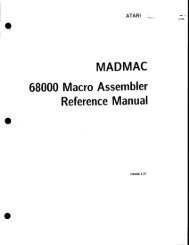

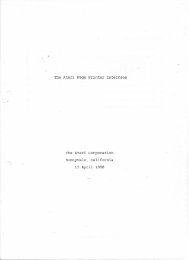
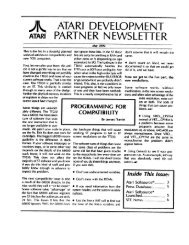
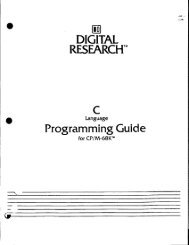
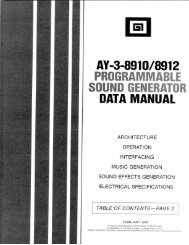
![Atari SM124 Service Manual P/N 483-303A (MT-9) [undated]](https://img.yumpu.com/48032932/1/184x260/atari-sm124-service-manual-p-n-483-303a-mt-9-undated.jpg?quality=85)
![Atari ST System-on-Chip in VHDL (Author: Lyndon Amsdon) [undated]](https://img.yumpu.com/47154349/1/190x245/atari-st-system-on-chip-in-vhdl-author-lyndon-amsdon-undated.jpg?quality=85)
![XBoot - The Boot Manager [1991] - Atari Documentation Archive](https://img.yumpu.com/44024401/1/190x135/xboot-the-boot-manager-1991-atari-documentation-archive.jpg?quality=85)
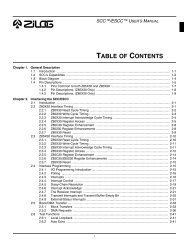
![Atari Megafile 30 & 60 Service Manual (RLL) [undated]](https://img.yumpu.com/41201963/1/189x260/atari-megafile-30-60-service-manual-rll-undated.jpg?quality=85)
![Atari Mega ST2/ST4 Schematic Rev 9 C100166 [Feb 19, 1987]](https://img.yumpu.com/41157604/1/184x260/atari-mega-st2-st4-schematic-rev-9-c100166-feb-19-1987.jpg?quality=85)

